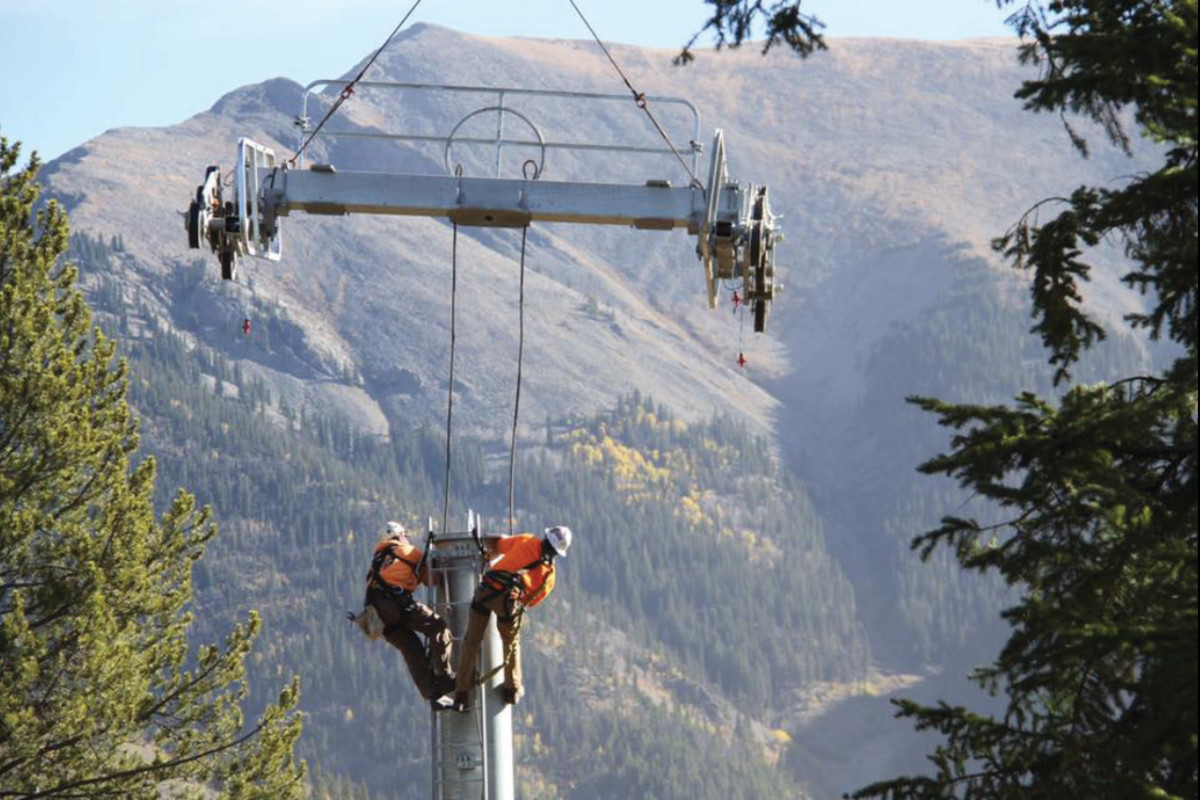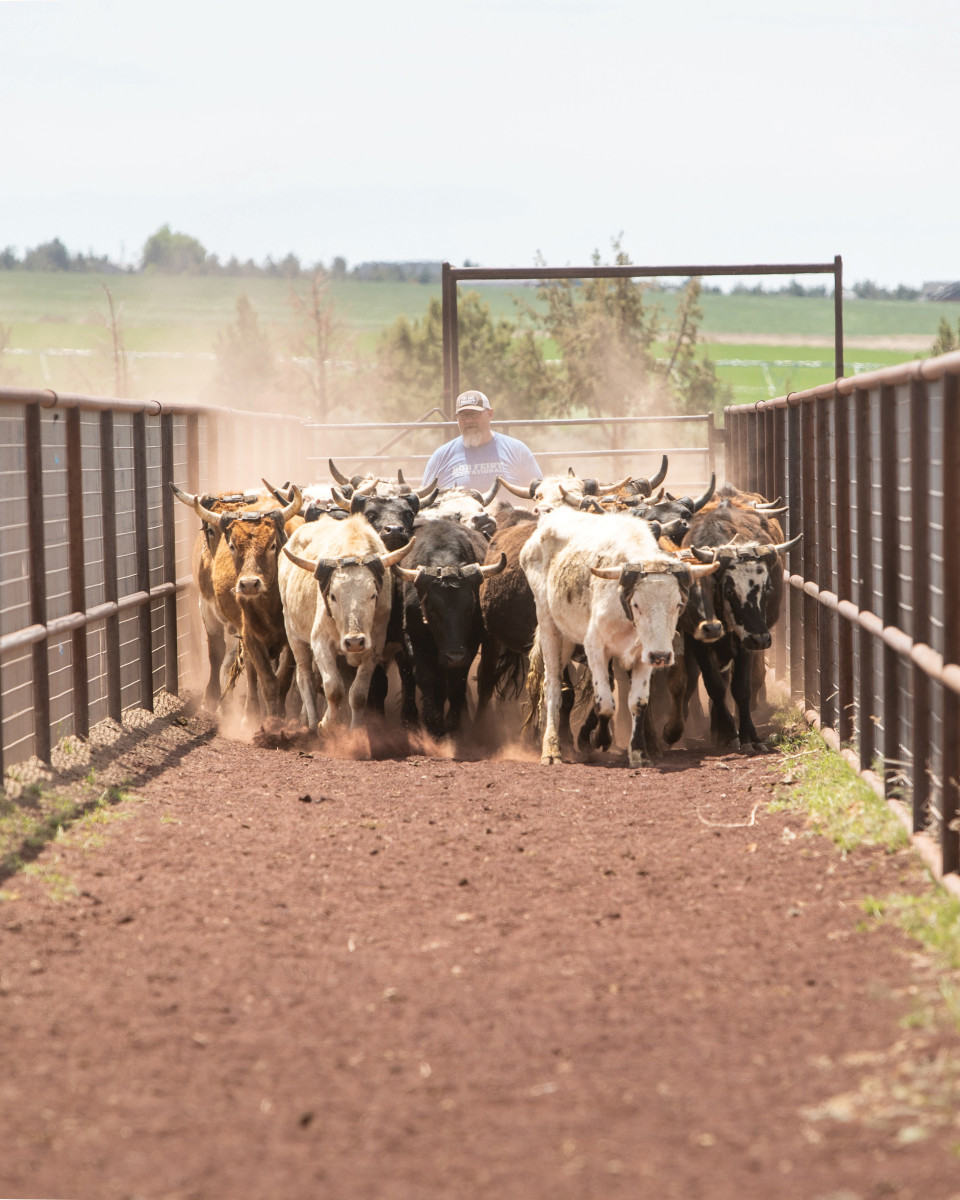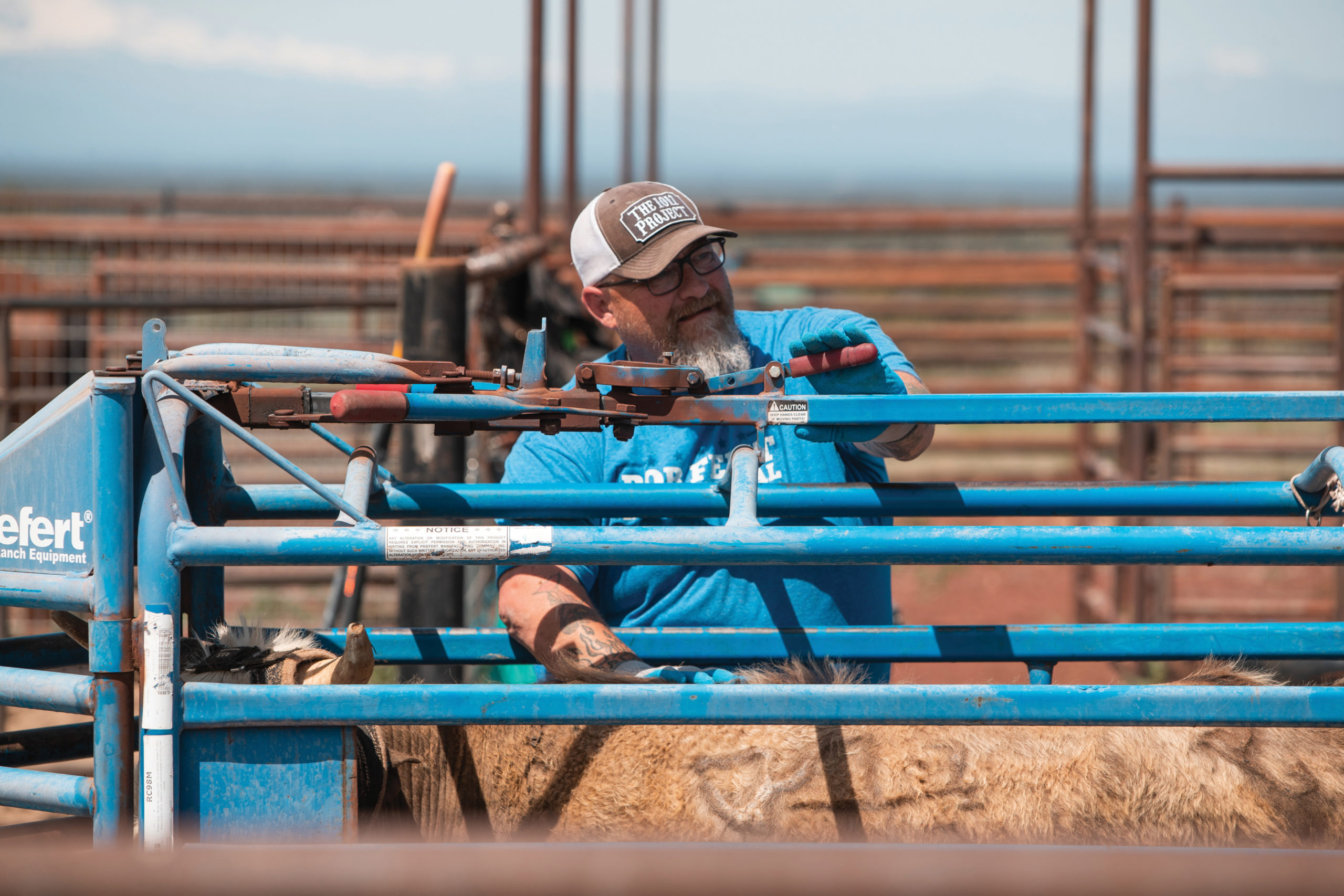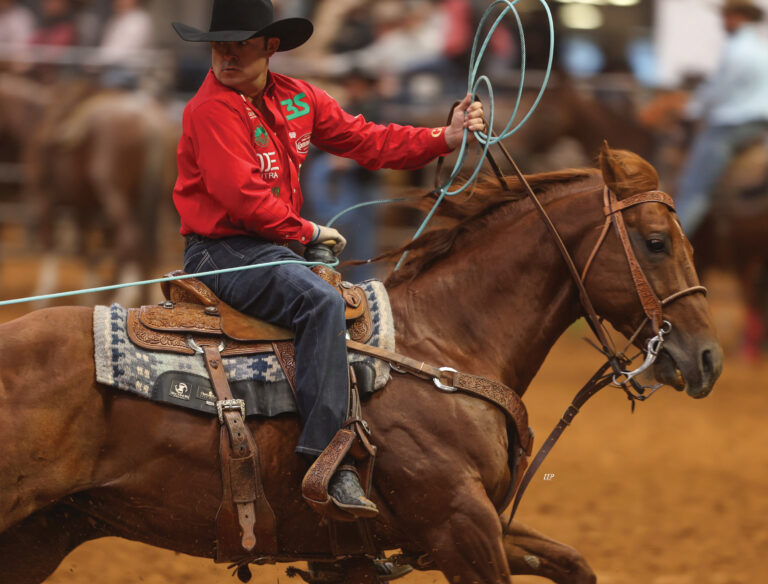”He’d never been around it. Had never been around cattle. He couldn’t have told you what end to feed and what end to kick.”
Pastor Jordan Weaver of Oregon’s 1017 Project, which helps battle food insecurity by providing roped-out steers to community food banks, offers a little background on Jason Graham, a member of the church who simply showed up one day and decided he wanted to help out at the team roping practices.
Graham, 51, was no cowboy. Rather, he was an acclaimed welder who committed to working on a ski resort kitchen line one day a week to get a season pass for his whole family, which included his wife, Sheri, and three sons, Taylor, Conner and Mayson. He caught the mountain life bug and realized he could still provide for his family if he could get a position with the ski lift maintenance team. He set to work.
“This place was year-round,” Graham explained about the work opportunity. “Those were not the top-paying jobs, but they were sustainable income for a father—a husband with a family. So, I bugged the lift manager for, geez it was probably a year. Every Friday. Finally, he was like, ‘You’re late. I was expecting you here for lunch.’ But every Friday, I’d go, and I’d say, ‘Hey, you got a job?’”
Graham’s persistence paid off. At first, he was given a position as a lift operator at minimum wage, but it wasn’t two weeks before he was told to order his maintenance uniform.

“They saw I shouldn’t be an operator,” Graham said. “I started with maintenance and it was probably four or five months later, and I was the lead mechanic. When I went to ski lifts, I was a really good welder, but when I was talking to the field manager, I told him I really didn’t want to weld anymore. I’d spent like the last 12 to 15 years welding. He was like, ‘Cool, I just need a mechanic,’ but then they found out what kind of welder I was and then, I was out hanging off towers and welding on towers and then I became the mountain welder.”
The job created more opportunities for Graham than he ever expected. He became the go-to guy for snowcat welding jobs and started doing work at all of the resorts. Then the ski lift manufacturers took notice and had Graham manufacturing parts for them. Eventually, they flew him around the world for work.
The Score: Season 2, Episode 7: The 1017 Project’s Pastor Jordan Weaver
Graham doesn’t characterize himself as an adrenaline junkie, but says his wife would suggest otherwise. Whether he seeks thrill or not, his mountain occupation provided it in abundance, and Graham loved every bit of it.
“Oh, it was awesome,” he exclaimed. “You can’t imagine. You saw every sunrise; you saw most sunsets; you saw incredible views. It was an awesome, thrilling, exciting job. You’re hanging 60 feet off the ground and you’re laid out horizontal, you know, attached with harnesses and stuff, and you’re laying horizontal working on stuff, trying to get a kid unhooked from a chair. I mean, it was adrenaline every day, all day long.
“I’ve done quite a few rescues; quite a few body recoveries; quite a few rescues that turned into body recoveries. Blizzards. We were up at the top of the mountain and they had a wind gauge. We were in a snowcat in 130 mph winds. We decided to get out and race to a ski lift pole to see who would win. That’s the kind of stuff that we did. When you punched in, you expected to get an intense day, no matter what you did.”
To point out, 130 mph winds are classified as a Category 4 hurricane. Graham and his mates effectively had a foot race in a Cat.-4 hurricane on a mountaintop at an altitude of probably 10,000 feet or more. For fun. Graham may not be an adrenaline junkie, but he sure thrived in an environment that challenged him mentally and physically every day. Until he didn’t.
In 2002, a group of Mt. Hood climbers fell into a crevasse and had to be rescued. The news crew was in the air, shooting footage that’s still available to watch online today of the second helicopter’s rescue, when the bird dipped into the mountain, propellers blasting off the rotor and the body of the chopper somersaulting down the slope, spewing flight crew as it rolled. On a ridge between the crash and the videographer, a group or four or five people are climbing up the mountain to provide rescue assistance. Graham is one of those people.
Then, about 10 years ago, he was the one who required rescue.
“I did that [job] for about 15 years and I had a really bad accident, and the end result was that I probably shouldn’t be here. I had to start over. Learn how to walk again. Learn how to do complete sentences. I really didn’t know what I was going to do with my life.”
Despite the doctors telling him that he needed to prepare to live a life of disability, Graham set his sights on returning to his beloved job.
“I told everybody, ‘I’m going back to being a lift mechanic. This is just a setback. I’ve been hurt before. Never this bad. But I’ve been hurt before. You take your downtime, you come back. You always come back pretty much the same.’ And I just always said I was going to be a lift mechanic.”
It was a hope he held onto for four or five years despite crushing odds. Not only was he struggling with physical challenges, but getting worker’s comp insurance coverage became a battle royale.
“It was about four years before I felt remotely like I was going to get better. And I would say it was about 6.5–7 years after the accident before I quit using my cane or any assistance to walk. It was obviously, 100%, a work accident. But I fought with workman’s comp for about four years and basically lost everything in that process before I was finally accepted as a workman’s comp client. They didn’t actually admit it, but I said, ‘The only reason that you’re doing this is you’re trying to starve me out to where I have to accept your measly offer.’ They basically said, ‘You’re right.’
“I had nowhere to go and nothing to lose, so, I couldn’t. I couldn’t accept their offer because I couldn’t go to work. I couldn’t just say, ‘Ok,’ so then the next day I’m responsible for my income. There was no way I could do that.”
Things got dark for Graham when, four or five years into recovery, he got a call from his retirement investor. The company had let Graham go, but nobody had told him.
[DONATE: Contribute to The 1017 Project’s Cause]
“That was kind of the ‘let-the-air-out-of-the-balloon moment.’ That’s when it was just kind of like, ‘Crap, I have nothing.’ It was past the point where my children had to put my shoes and socks on, but, I couldn’t go back to being a welder.”
“There was a lot of, ‘Where am I gonna be, what am I gonna do? How am I going to help society? What’s my input going to be? There was a lot of worthless moments, you know. And I’ll admit, there was counseling involved. It was a bad, bad time.”
As far as physical build goes, Graham registers on the hossy side of the spectrum.
“He’s a big guy,” Weaver stated. “He’s like 6’2, maybe weighs 290–300 pounds. He’s a big guy, right? He’s got a very serious demeanor and tattoos all over him. He’s like a grizzly bear wearing people clothes.”
The accident, and all the battles that ensued, however, took a great toll. Putting his injury and the effect it had on his family and the realization that he would never again be a mountain welder into words, Graham struggles to keep his emotions in check. There is a deep hurt in all of it.

“If you ask my wife,” he offered, “it was not the best time in our marriage. It was a weird time in my life, too, and it was just like, ‘How could it keep spiraling downhill?’”
As Graham found his way, though, he discovered that movement was key.
“I constantly have to move. Once I stop moving, everything starts to settle and hurt. That’s why I’m always going.”
Team roping, he also discovered, provided much of what Graham thought was gone forever.
About two years ago, Graham joined Weaver’s church and heard about the practices. Not unlike when he decided he needed to be on the lift maintenance team, he pursued the opportunity to pitch in persistently.
“So, he started volunteering for the cattle project,” Weaver said. “He showed up and said I want to help. The guy that was running it, to be honest, kinda blew him off a little bit.”
To be fair, Graham brought zero knowledge of cattle or roping to the table.
“I had been to a few rodeos,” he admitted. “I kind of knew what team roping was. It was two cowboys and a cow. But I went and I sat in the stands while they did their practice for weeks just to figure out what was going on and I said, ‘Ok, I think I can probably do this.’ I wanted to do the stripping chute, because I thought that was going to be intense. That’s what I was looking for. I thought that was the most intense thing I could possibly do.”
Then, however, Graham realized he needed to be at the head gate.
“I had no clue what I was doing, and people were yelling at me. ‘Don’t do this, do this!’ It was so crazy. I fell in love with it. But then the next week I ran the head box, and it was like, ‘Now this is where I need to be. Right here at this head box.’ It’s not really a control thing, but I can see more, and I can be more involved. And it’s worked out that I can be a really good boss from the head gate because I can see the rest of my crew from there.”
That’s right. Nearly two years into his chute induction, Graham is running his own crew again.
“He was as completely disconnected from the whole team roping culture as you can be,” Weaver marveled, “but he saw something that he could do, so he’s got a team put together. He’s working all the World Series, all the ACTRAs, all the little local jackpots. We put on the NTRs. He runs it as though that’s his calling in life.”
For Graham, the bigger and more challenging a roping, the better.
“Multiple times, we’ve done 90–100 teams an hour. And I know that we’ve beat 120. We had a kid working for me and he was so into numbers. He was always yelling at me. ‘You gotta hurry. You got 4 more minutes; you need 10 more teams for 110 teams in an hour.’ That started pushing me a little bit. He was pushing me to go faster and that’s what I try to do. I try to go through as fast as I can. And try to give every header the same exact start. I want to give everybody the perfect start, no matter if you’re running the #14 or running a #7. No matter what you’re running, I want every header to get the exact same start the last header got.”
According to Weaver, Graham isn’t just succeeding as a chute boss—in the region, he’s impacting the sport itself.
“I’m telling you, our ropings run as efficiently as you can imagine. He said he runs the whole thing like he took everything he used to use from the welding background and applied it to running the chute deal. He is revolutionizing the team roping deal up there.
“Here’s the other thing,” Weaver continued, “being a mechanic, it doesn’t matter what breaks. That guy can fix it. Jason is right there and knows exactly what to do to get it to work. When something breaks and the roping producer looks to Jason as kind of the captain of the ship, that’s such a testament to how he treats it.”
Graham also treats it like it’s own professional sport.
“What I ask people is, ‘Why are rodeo competitors the only ones that try to get to the NFR?’ I’d like to do all of the big ones. The American. The NFR. World Series Finale. Why not?”
[SHOP: Cattle-Raising Essentials]
Rechargeable Electric Livestock Prod for Cow Pig Goats and More
Priefert “Rancher” Squeeze Chute
(As an Amazon Associate, we earn from qualifying purchases made through affiliate links.)
For a husband and father of three, shifting into the team roping community is not a solo endeavor and, understandably, Graham’s wife had a few reservations.
“She was real nervous about it for a while. But when she saw how …,” Graham said, stopping to take a moment. “That fire. The light,” he continued. “She saw that there was something that brightened my day, maybe.”
Not unlike many team roping wives, Mrs. Graham doesn’t love that her husband now spends weekends away at the numerous ropings, but recognizes the benefit outweighs the cost.
“She doesn’t like when I go away for the weekends,” Graham explained. “But she knows how good it is for me.”
According to Graham, running the chutes hasn’t only given him back his sense of purpose and the thrill of life, it’s also aided in his physical recovery.
“I can do stairs a little bit better. I don’t do stairs one step at a time anymore.”
Taking stairs a step at a time stands in stark contrast to running nearly 100 teams an hour. And that most ropers have likely never realized Graham’s condition is an incredible demonstration of his soulful willpower, as well as his love of team roping and the community.
“People out here are genuine people and I like being treated with respect,” Graham said. “Right now, I’m in heaven. It’s a good place to be and I love team roping.”











